Socio-Economic Decision Making and Emotion Elicitation with a Serious Game in the Wild
Abstract
1. Introduction
2. Related Works
3. Game Design
3.1. Game Requirements
- (R1)
- The game should be able to elicit specific emotions and decision-making patterns in its players as seen in the literature for relevant socio-economic scenarios.
- (R2)
- The game should be immersive and engaging enough to minimise the contextual variability around a player.Emotions can be influenced by many different factors in the wild, mostly the environment and the player’s pre-existing mood. These factors are known as contextual variability [54,66,68,71]. It is essential for a game to be immersive in order to engage the player well enough for reducing the impact of contextual variability [139].
- (R3)
- The game must be supported on popular platforms so as to make it possible for a larger population to play the game.There are obvious technological constraints of the technological nature for implementing a SG for emotion elicitation, for instance, the availability of hardware, software, and compatibility of the game [75]. This requirement refers tothe fact that a game which is usable in the wild would need to run on widely available platforms.
- (R4)
- The game should have a mechanism for emotion measurement that does not interrupt the progression of the storyline or gaming experience.
- (R5)
- The storyline, dynamics and NPC interactions should be designed keeping the cultural influence in mind for the intended players.This requirement is related to the challenge of cultural sensitivity, meaning that the mobile SG to be used for emotion elicitation needs to seem culturally relevant to the players. Mobile SGs for emotion elicitation must be designed to keep cultural influences in consideration, as emotions can vary greatly between cultures and it is important to be aware of cultural sensitivities and to design the game in a way that is culturally appropriate for the intended players [72,73].
3.2. Design Decisions
- After interacting with an NPC, the player is informed of their next objective.
- Interacting with an NPC can either positively or negatively impact one of the game’s resources, which is represented by a change in the corresponding player status bar on the game’s interface.
- To progress to the next level, the player must maintain at least two out of three resources at a level above “low” or in the “green” range on the player status bar.
- The player must navigate between sites of interaction while staying within the road bump barriers. Colliding with these barriers will reduce the player’s health bar, adding an element of risk and engagement to the gameplay experience, and keeping the player in the “flow” [21,24]. Additionally, the base mechanic regarding the movement of the player character has been kept flexible and straightforward, meaning the player character can freely move around the 3D world (on paved and unpaved roads, on the grass, inside the buildings, etc., if the player chooses to jump over the bump barriers and create his own shortcuts through the terrain to the next task location, as free-form movement is beneficial to make task-based games enjoyable and motivating [160]).
- The game includes a navigation arrow that directs the player to the next NPC and a map that displays the locations of all NPCs in the scene, as well as the player’s current location.
- The game design ensures that socio-economic interactions cannot directly lead to a failure of game progression, as this could cause unexpected emotional responses from players [21,24,27,161]. Therefore, the mechanic of requiring two resources to be maintained at a level above “low” is essential for successful completion of the level, as it guarantees that there is no direct connection between socio-economic interactions and failure to progress in the game.
3.3. User-Interface
3.4. Socio-Economic Decision Making Interactions
- Ultimatum GameIn this game, there are two players, a proposer and a responder. The proposer is given some money and is asked to propose a split amount with the responder. The responder can accept or reject the offer. If the responder accepts the offer, the two players split the amount according to the agreement, if the responder rejects the offer, the responder and the proposer do not get any money from the game. In our game, the NPC plays the role of the ‘proposer’ and the player character is the ‘responder’. Furthermore, the interaction is designed as such that the NPC makes an unfair offer and the polarity of the interaction is negative, meaning that the NPC dialogues are condescending and slightly rude but not offensive, as such interactions in UG settings have been shown to produce more distinct negative emotional responses with higher valence [26,151,166]. Figure 3 shows a part of the dialogue between the NPC for this interaction and the player character.
- Trust GameIn this game, there are two players, a trustor and a trustee. The trustor is given some resource, e.g., money and is asked to propose a split amount with the trustee. The trustee can accept or reject the offer. Whatever amount is given to the trustee is double/tripled by the game. However, the trustee has the freedom to choose whether or not to repay the trustor any amount from the income made from the game. In our game, the NPC plays the role of the ‘trustee’ and the player character is the ‘trustor’. Here, the interaction is designed as such that if the player chooses to trust the NPC with its resources (which is food for this interaction), the NPC chooses to reward the player for it and returns the player’s share on the profit to the player. The polarity of the interaction is positive, meaning that the NPC dialogues are uplifting and indicating gratefulness of the NPC. This is due to two reasons, firstly to balance the negative approach of the NPC in the previous UG interaction, as prolonged negativity from NPCs can effect the decisions of the player [167] and secondly as positive polarity interactions in TG settings promote co-operation [168]. Figure 4 shows a part of the dialogue between the NPC for this interaction and the player’s character.
- Dictator GameIn this game, there are two players, a dictator and a responder. The dictator is given some money and is asked to donate a fraction (or the whole amount) with the recipient. The responder has to accept the donation and has no other choice. The dictator also has the option of not donating any amount at all to the recipient and the recipient has no say in this game. In our game, the player character plays the role of the ‘dictator’ and the NPC is the ‘responder’. This interaction is designed as such that if the player chooses to donate some of its resources (which is money for this interaction) to the NPC then the NPC expresses its gratitude for the generosity of the player. Otherwise, the NPC is still polite and the interaction has a positive polarity. This interaction having a positive polarity is important as it will ensure that the prior TG interaction having a positive polarity will not seem like a one-off phenomenon in the game and will solidify the notion that not all NPCs in our game’s world are rude. This will also provide a better impact for the next interaction being of a negative polarity again as any changes in the narrative of a game elicits stronger emotional responses in the players [169]. Figure 5 shows a part of the dialogue between the NPC for this interaction and the player’s character.
- In this game, there are three players, a jailer, prisoner A and prisoner B. Both the prisoners are interrogated by the jailer regarding a crime they are accused of, if both the prisoners accuse each other of being guilty, they both get one year of prison/low damage or punishment of some arbitrary type. If both the prisoners do not accuse each other for being guilty, they both get five years of prison/moderate damage or punishment of some arbitrary type. If one of them, for instance prisoner A, accuses prisoner B of being guilty while prisoner B does not accuse prisoner A, then prisoner A will walk free and prisoner B will get ten years of prison/the highest damage or punishment of some arbitrary type. The flipped situation of prisoner B accuses A while A does not accuse B, prisoner A will receive the highest damage or punishment of some arbitrary type. In our game, the NPCs play the role of the ‘jailer’ and the ‘prisoner B’ while the player’s character is ‘prisoner A’. Lastly, the interaction is designed as such that the player chooses to help an NPC (let us call it prisoner-NPC) to complete the final task’s objective and by being associated with the prisoner-NPC, the player becomes an accomplice in the eyes of the second NPC (let us call it the jailer-NPC). This interaction is specifically designed to orchestrate a betrayal from the prisoner-NPC, which is supposed to elicit a high valence of negative emotional response [170]. Figure 6 shows a part of the dialogue between the prisoner NPC for this interaction and the player character, while Figure 7 shows a part of the dialogue between the jailer NPC for this interaction and the player’s character, explaining the rules of the interaction.
3.5. Emotion Self-Reporting
4. Experiment
4.1. Decisions of Interest and Emotion Data
4.2. Methodology
5. Analysis
6. Results and Discussion
7. Conclusions and Future Works
Author Contributions
Funding
Institutional Review Board Statement
Informed Consent Statement
Data Availability Statement
Conflicts of Interest
Abbreviations
| NPC | Non-Player Character |
| RPG | Role Playing Games |
| GEQ | Game Engagement Questionnaire |
| QMERC | Queen Mary Ethics of Research Committee |
| DoI | Decision of Interest |
| UI | User Interface |
| UG | Ultimatum Game |
| TG | Trust Game |
| DG | Dictator Game |
| PDG | Prisoner’s Dilemma Game |
| SG | Serious Games |
Appendix A
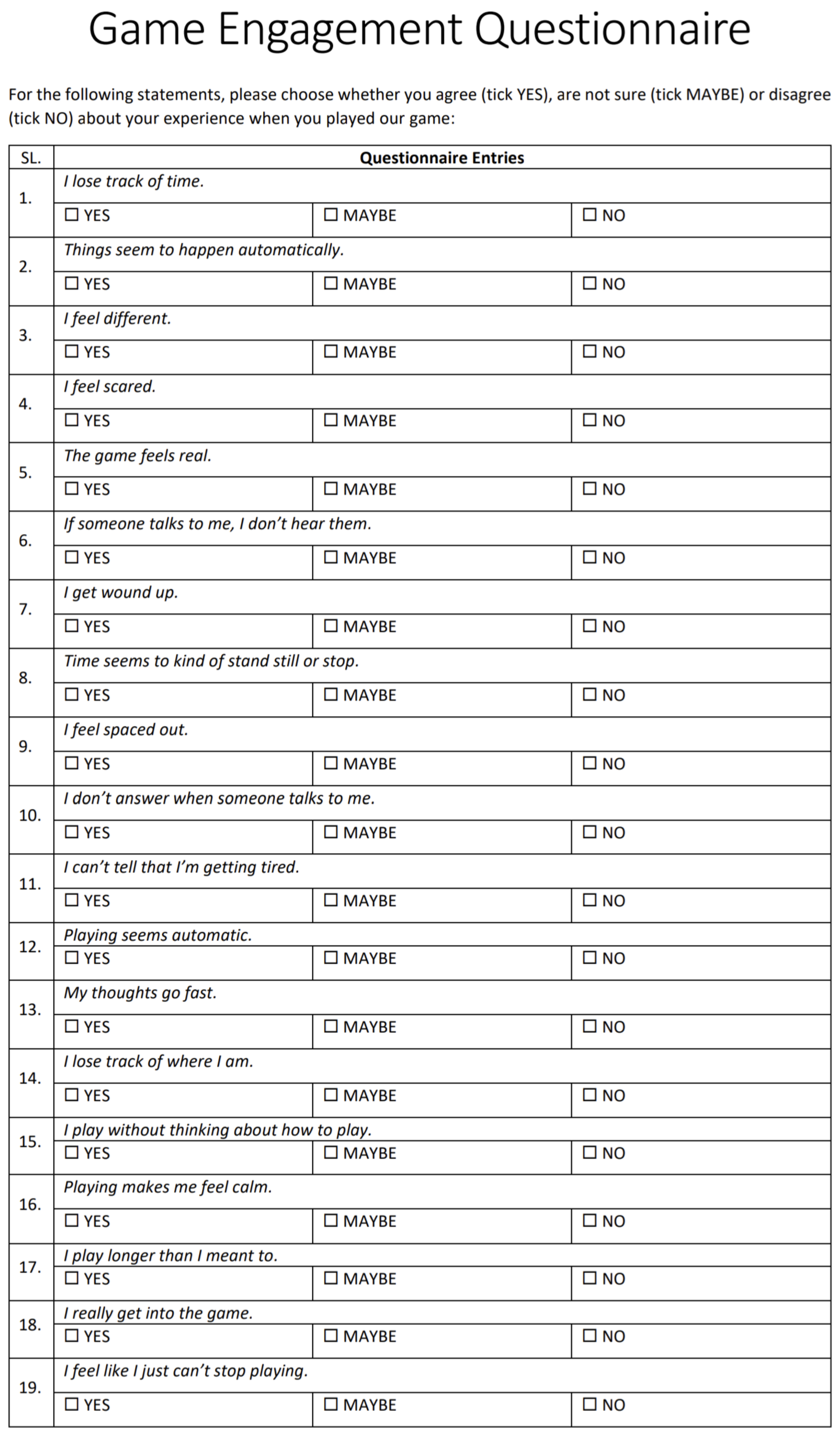
References
- Damasio, A. The somatic marker hypothesis and the possible functions of the prefrontal cortex. Philos. Trans. R. Soc. London. Ser. B Biol. Sci. 1996, 351, 1413–1420. [Google Scholar]
- Roelofs, K.; Minelli, A.; Mars, R.; Peer, J.; Toni, I. On the neural control of social emotional behavior. Soc. Cogn. Affect. Neurosci. 2009, 4, 50–58. [Google Scholar] [CrossRef] [PubMed]
- Borries, A.; Volman, I.; Bruijn, E.; Bulten, B.; Verkes, R.; Roelofs, K. Psychopaths lack the automatic avoidance of social threat: Relation to instrumental aggression. Psychiatry Res. 2012, 200, 761–766. [Google Scholar] [CrossRef] [PubMed]
- Gambetti, E.; Giusberti, F. The effect of anger and anxiety traits on investment decisions. J. Econ. Psychol. 2012, 33, 1059–1069. [Google Scholar] [CrossRef]
- Huntsinger, J.R.; Ray, C. Emotion and Decision Making. In Emerging Trends in the Social and Behavioral Sciences, Cognition and Emotions, Decision Making; John Wiley & Sons: Hoboken, NJ, USA, 2015; pp. 1–16. [Google Scholar] [CrossRef]
- Seymour, B.; Dolan, R. Emotion, Decision Making, and the Amygdala. Neuron 2008, 58, 662–671. [Google Scholar] [CrossRef]
- Lerner, J.S.; Li, Y.; Valdesolo, P.; Kassam, K.S. Emotion and Decision Making. Annu. Rev. 2015, 66, 799–823. [Google Scholar] [CrossRef]
- Rilling, J.K.; Sanfey, A.G. The Neuroscience of Social Decision-Making. Annu. Rev. Psychol. 2011, 62, 23–48. [Google Scholar] [CrossRef]
- Västfjäll, D.; Slovic, P.; Burns, W.J.; Erlandsson, A.; Koppel, L.; Asutay, E.; Tinghög, G. The arithmetic of emotion: Integration of incidental and integral affect in judgments and decisions. Front. Psychol. 2016, 7, 325. [Google Scholar] [CrossRef]
- Leo, M. Automatic Emotion Recognition in Robot-Children Interaction for ASD Treatment. In Proceedings of the IEEE International Conference on Computer Vision, Santiago, Chile, 7–13 December 2015. [Google Scholar]
- Suslow, T.; Junghanns, K.; Arolt, V. Detection of facial expressions of emotions in depression. Percept. Mot. Skills 2001, 92, 857–868. [Google Scholar] [CrossRef]
- Tivatansakul, S.; Ohkura, M.; Puangpontip, S.; Achalakul, T. Emotional healthcare system: Emotion detection by facial expressions using Japanese database. In Proceedings of the 2014 6th Computer Science and Electronic Engineering Conference (CEEC 2014), Colchester, UK, 25–26 September 2014; pp. 41–46. [Google Scholar]
- Picard, R.W. Toward computers that recognize and respond to user emotion. IBM Syst. J. 2000, 39, 705–719. [Google Scholar] [CrossRef]
- Mello, S.K.D.; Craig, S.D.; Gholson, B.; Franklin, S.; Picard, R.; Graesser, A.C. Integrating Affect Sensors in an Intelligent Tutoring System. In Proceedings of the Affective Interactions: The Computer in the Affective Loop Workshop at 2005 International Conference on Intelligent User Interfaces, San Diego, CA, USA, 10–13 January 2005. [Google Scholar]
- Juretić, J.; Živčić-Bećirevic, I. Social Anxiety, Beliefs about Expressing Emotions and Experiencing Positive Emotions; IntechOpen: London, UK, 2013. [Google Scholar] [CrossRef]
- Jacob, G.A.; Hellstern, K.; Ower, N.; Pillmann, M.; Scheel, C.N.; Rüsch, N.; Lieb, K. Emotional reactions to standardized stimuli in women with borderline personality disorder: Stronger negative affect, but no differences in reactivity. J. Nerv. Ment. Dis. 2009, 197, 808–815. [Google Scholar] [CrossRef]
- Staebler, K.; Gebhard, R.; Barnett, W.; Renneberg, B. Emotional responses in borderline personality disorder and depression: Assessment during an acute crisis and 8 months later. J. Behav. Ther. Exp. Psychiatry 2009, 40, 85–97. [Google Scholar] [CrossRef]
- Domes, G.; Schulze, L.; Herpertz, S.C. Emotion recognition in borderline personality disorder—A review of the literature. J. Personal. Disord. 2009, 23, 6–19. [Google Scholar] [CrossRef]
- Wei, C.; Han, J.; Zhang, Y.; Hannak, W.; Liu, Z. The Characteristics of Emotional Response of Post-traumatic Stress Disorder and Post-traumatic Growth among Chinese Adults Exposed to an Explosion Incident. Front. Public Health 2017, 5, 3. [Google Scholar] [CrossRef]
- Harlé, K.M.; Sanfey, A.G. Incidental sadness biases social economic decisions in the Ultimatum Game. Emotion 2007, 7, 876–881. [Google Scholar] [CrossRef]
- The impact of depression on social economic decision making. J. Abnorm. Psychol. 2010, 119, 440–446. [CrossRef]
- Hu, Y.; Zhou, M.; Shao, Y.; Wei, J.; Li, Z.; Xu, S.; Maguire, P.; Wang, D. The effects of social comparison and depressive mood on adolescent social decision-making. BMC Psychiatry 2021, 21, 3. [Google Scholar] [CrossRef]
- Watanabe, K. Others behind action, emotion, and decision. Brain Nerve 2009, 61, 1413–1418. [Google Scholar]
- Sorgi, K.M.; van’t Wout, M. The influence of cooperation and defection on social decision making in depression: A study of the iterated Prisoner’s Dilemma Game. Psychiatry Res. 2016, 246, 512–519. [Google Scholar] [CrossRef]
- Gabay, A.S.; Radua, J.; Kempton, M.J.; Mehta, M.A. The Ultimatum Game and the brain: A meta-analysis of neuroimaging studies. Neurosci. Biobehav. Rev. 2014, 47, 549–558. [Google Scholar] [CrossRef]
- Tamarit, I.; Sánchez, A. Emotions and Strategic Behaviour: The Case of the Ultimatum Game. PLoS ONE 2016, 11, e0158733. [Google Scholar] [CrossRef] [PubMed]
- Wang, Y.; Zhou, Y.; Li, S.; Wang, P.; Wu, G.W.; Liu, Z.N. Impaired social decision making in patients with major depressive disorder. BMC Psychiatry 2014, 14, 18. [Google Scholar] [CrossRef] [PubMed]
- Zhang, H.J.; Sun, D.; Lee, T.M. Impaired social decision making in patients with major depressive disorder. Brain Behav. 2012, 2, 415–423. [Google Scholar] [CrossRef] [PubMed]
- Sally, D.; Hill, E. The development of interpersonal strategy: Autism, theory-of-mind, cooperation and fairness. J. Econ. Psychol. 2006, 27, 73–97. [Google Scholar] [CrossRef]
- Mailliez, M.; Bollon, T.; Graton, A.; Hot, P. Can the induction of incidental positive emotions lead to different performances in sequential decision-making? Cogn. Emot. 2020, 34, 1509–1516. [Google Scholar] [CrossRef]
- Schwarz, N. Feelings as Information: Moods Influence Judgments and Processing Strategies. In Heuristics and Biases; Cambridge University Press: Cambridge, UK, 2002; pp. 534–547. [Google Scholar] [CrossRef]
- Wyczesany, M.; Kaiser, J.; Coenen, A.M. Associations Between Self-Report of Emotional State and the EEG Patterns in Affective Disorders Patients. J. Psychophysiol. 2010, 24, 33–40. [Google Scholar] [CrossRef]
- Six, S.G.; Byrne, K.A.; Tibbett, T.P.; Pericot-Valverde, I. Examining the Effectiveness of Gamification in Mental Health Apps for Depression: Systematic Review and Meta-analysis. JMIR Ment. Health 2021, 8, e32199. [Google Scholar] [CrossRef]
- Association, A.P. Diagnostic and Statistical Manual of Mental Disorders; American Psychiatric Association Publishing: Washington, DC, USA, 2022. [Google Scholar] [CrossRef]
- Piras, L.; Paja, E.; Giorgini, P.; Mylopoulos, J.; Cuel, R.; Ponte, D. Gamification solutions for software acceptance: A comparative study of Requirements Engineering and Organizational Behavior techniques. In Proceedings of the International Conference on Research Challenges in Information Science, Brighton, UK, 10–12 May 2017; pp. 255–265. [Google Scholar] [CrossRef]
- Burr, D.A.; Pizzie, R.G.; Kraemer, D.J. Anxiety, not regulation tendency, predicts how individuals regulate in the laboratory: An exploratory comparison of self-report and psychophysiology. PLoS ONE 2021, 16, e0247246. [Google Scholar] [CrossRef]
- Nash, D.; Heiss, J. Sources of Anxiety in Laboratory Strangers. Sociol. Q 1967, 8, 215–221. [Google Scholar] [CrossRef]
- Larradet, F.; Niewiadomski, R.; Barresi, G.; Caldwell, D.G.; Mattos, L.S. Toward Emotion Recognition From Physiological Signals in the Wild: Approaching the Methodological Issues in Real-Life Data Collection. Front. Psychol. 2020, 11, 1111. [Google Scholar] [CrossRef]
- Steed, A.; Frlston, S.; Lopez, M.M.; Drummond, J.; Pan, Y.; Swapp, D. An ‘In the Wild’ Experiment on Presence and Embodiment using Consumer Virtual Reality Equipment. IEEE Trans. Vis. Comput. Graph. 2016, 22, 1406–1414. [Google Scholar] [CrossRef]
- Griffiths, P.; Scarantino, A. Emotions in the Wild: The Situated Perspective on Emotion; Cambridge University Press: Cambridge, UK, 2012; pp. 437–453. [Google Scholar] [CrossRef]
- Ataizi, M. Situated Cognition. In Encyclopedia of the Sciences of Learning; Springer: Boston, MA, USA, 2012; pp. 3082–3084. [Google Scholar] [CrossRef]
- Callon, M.; Rabeharisoa, V. Research “in the wild” and the shaping of new social identities. Technol. Soc. 2003, 25, 193–204. [Google Scholar] [CrossRef]
- Rogers, Y.; Connelly, K.; Tedesco, L.; Hazlewood, W.; Kurtz, A.; Hall, R.E.; Hursey, J.; Toscos, T. Why It’s Worth the Hassle: The Value of in-Situ Studies When Designing Ubicomp. In Proceedings of the 9th International Conference on Ubiquitous Computing (UbiComp ‘07), Innsbruck, Austria, 16–19 September 2007; pp. 336–353. [Google Scholar]
- Kulp, L.; Sarcevic, A. Design In The Wild: Lessons From Researcher Participation In Design Of Emerging Technology. In Proceedings of the 2017 CHI Conference Extended Abstracts on Human Factors in Computing Systems, Denver, CO, USA, 6–11 May 2017; p. 1802. [Google Scholar] [CrossRef]
- Chamberlain, A.; Crabtree, A.; Rodden, T.; Jones, M.; Rogers, Y. Research in the wild: Understanding ‘in the wild’ approaches to design and development. In Proceedings of the Designing Interactive Systems Conference (DIS ‘12), Newcastle Upon Tyne, UK, 11–15 June 2012; pp. 795–796. [Google Scholar] [CrossRef]
- Barkley, R.A. The ecological validity of laboratory and analogue assessment methods of ADHD symptoms. J. Abnorm. Child Psychol. 1991, 19, 149–178. [Google Scholar] [CrossRef]
- Scionti, N.; Marzocchi, G.M. The dimensionality of early executive functions in young preschoolers: Comparing unidimensional versus bidimensional models and their ecological validity. Child Neuropsychol. 2021, 27, 491–515. [Google Scholar] [CrossRef]
- Crist, P.A. Framing Ecological Validity in Occupational Therapy Practice. Open J. Occup. Ther. 2015, 3, 11. [Google Scholar] [CrossRef]
- Brooks, P.; Hestnes, B. User measures of quality of experience: Why being objective and quantitative is important. IEEE Netw. 2010, 24, 8–13. [Google Scholar] [CrossRef]
- Bromley, E.; Mikesell, L.; Mates, A.; Smith, M.; Brekke, J.S. A Video Ethnography Approach to Assessing The Ecological Validity of Neurocognitive and Functional Measures in Severe Mental Illness: Results From A Feasibility Study. Schizophr. Bull. 2012, 38, 981. [Google Scholar] [CrossRef]
- Wang, J.; Geng, L. Effects of Socioeconomic Status on Physical and Psychological Health: Lifestyle as a Mediator. Int. J. Environ. Res. Public Health 2019, 16, 281. [Google Scholar] [CrossRef]
- Migeot, J.; Calivar, M.; Granchetti, H.; Ibáñez, A.; Fittipaldi, S. Socioeconomic status impacts cognitive and socioemotional processes in healthy ageing. Sci. Rep. 2022, 12, 6048. [Google Scholar] [CrossRef]
- Alegría, M.; NeMoyer, A.; Bagué, I.F.; Wang, Y.; Alvarez, K. Social Determinants of Mental Health: Where We Are and Where We Need to Go. Curr. Psychiatry Rep. 2018, 20, 95. [Google Scholar] [CrossRef]
- Rapp, A.; Marcengo, A.; Console, L.; Simeoni, R. Playing in the wild. In Proceedings of the 16th International Academic MindTrek Conference, Tampere, Finland, 3–5 October 2012. [Google Scholar]
- Kopasker, D.; Montagna, C.; Bender, K.A. Economic insecurity: A socioeconomic determinant of mental health. SSM—Popul. Health 2018, 6, 184–194. [Google Scholar] [CrossRef]
- Mukherjee, S.; Boamah, E.F.; Ganguly, P.; Botchwey, N. A multilevel scenario based predictive analytics framework to model the community mental health and built environment nexus. Sci. Rep. 2021, 11, 17548. [Google Scholar] [CrossRef] [PubMed]
- Knapp, M.; Wong, G. Economics and mental health: The current scenario. World Psychiatry 2020, 19, 3. [Google Scholar] [CrossRef] [PubMed]
- Dodell-Feder, D.; Lincoln, S.H.; Coulson, J.P.; Hooker, C.I. Using Fiction to Assess Mental State Understanding: A New Task for Assessing Theory of Mind in Adults. PLoS ONE 2013, 8, e81279. [Google Scholar] [CrossRef] [PubMed]
- Fleming, T.M.; Bavin, L.; Stasiak, K.; Hermansson-Webb, E.; Merry, S.N.; Cheek, C.; Lucassen, M.; Lau, H.M.; Pollmuller, B.; Hetrick, S. Serious Games and Gamification for Mental Health: Current Status and Promising Directions. Front. Psychiatry 2016, 7, 215. [Google Scholar] [CrossRef]
- Sanz, C.; Artola, V.; Miceli, P.; Proceedings, J.B.E. AstroCode in the Wild. In Proceedings of the 10th International Conference on Education and New Learning Technologies, Palma, Spain, 2–4 July 2018. [Google Scholar]
- SchlÖgl, R.; Wimmer, C.; Grechenig, T. Hyper typer: A serious game for measuring mobile text entry performance in the wild. In Proceedings of the Conference on Human Factors in Computing Systems, Glasgow, UK, 4–9 May 2019. [Google Scholar] [CrossRef]
- Rogers, Y. Interaction design gone wild. Interactions 2011, 18, 58–62. [Google Scholar] [CrossRef]
- 23+ Mobile Gaming Statistics for 2022. Available online: https://techjury.net/blog/mobile-gaming-statistics/#gref (accessed on 5 January 2023).
- Baker, I.S.; Turner, I.J.; Kotera, Y. Role-play Games (RPGs) for Mental Health (Why Not?): Roll for Initiative. Int. J. Ment. Health Addict. 2022, 22, 1–9. [Google Scholar] [CrossRef]
- Baharom, S.N.; Tan, W.H.; Idris, M.Z. Emotional Design for Games: The Roles of Emotion and Perception in Game Design Process. In Proceedings of the Serious Games Conference 2014, Kintex, Republic of Korea, 23–24 May 2014; pp. 19–25. [Google Scholar] [CrossRef]
- Guthier, B.; Dörner, R.; Martinez, H.P. Affective computing in games. In Proceedings of the Lecture Notes in Computer Science (Including subseries Lecture Notes in Artificial Intelligence and Lecture Notes in Bioinformatics) (9970 LNCS), Dagstuhl Castle, Germany, 5–10 July 2015; pp. 402–441. [Google Scholar] [CrossRef]
- Brockmyer, J.H.; Fox, C.M.; Curtiss, K.A.; McBroom, E.; Burkhart, K.M.; Pidruzny, J.N. The development of the Game Engagement Questionnaire: A measure of engagement in video game-playing. J. Exp. Soc. Psychol. 2009, 45, 624–634. [Google Scholar] [CrossRef]
- Gitarana, G.R.E.; Fithratu, C.; Muis, A.N.; Darmakusuma, R. Analysis and Evaluation of Player Engagement in Serious Education Game using Game Refinement Theory Case Study: Arithmatopia Game. In Proceedings of the 6th International Conference on Interactive Digital Media (ICIDM 2020), Bandung, Indonesia, 14–15 December 2020. [Google Scholar] [CrossRef]
- Selvig, D.R.; Schoenau-Fog, H. Non-intrusive measurement of player engagement and emotions—Real-time deep neural network analysis of facial expressions during game play. In Proceedings of the Lecture Notes in Computer Science (Including Subseries Lecture Notes in Artificial Intelligence and Lecture Notes in Bioinformatics) (12211 LNCS), Copenhagen, Denmark, 19–24 July 2020; pp. 330–349. [Google Scholar] [CrossRef]
- Henrik, S.F. The Player Engagement Process 8211; An Exploration of Continuation Desire in Digital Games. In Proceedings of the 2011 DiGRA International Conference: Think Design Play (DiGRA ‘11), Hilversum, The Netherlands, 14–17 September 2011. [Google Scholar]
- Abdullah, S.Z.; Ali, N.M.; Lee, H. Exploring the user engagement in interacting with game interfaces. In Proceedings of the Lecture Notes in Computer Science (Including Subseries Lecture Notes in Artificial Intelligence and Lecture Notes in Bioinformatics) (8237 LNCS), Selangor, Malaysia, 13–15 November 2013; pp. 231–240. [Google Scholar] [CrossRef]
- Fridenson-Hayo, S.; Berggren, S.; Lassalle, A.; Tal, S.; Pigat, D.; Bölte, S.; Baron-Cohen, S.; Golan, O. Basic and complex emotion recognition in children with autism: Cross-cultural findings. Mol. Autism 2016, 7, 52. [Google Scholar] [CrossRef]
- Fridenson-Hayo, S.; Berggren, S.; Lassalle, A.; Tal, S.; Pigat, D.; Meir-Goren, N.; O’Reilly, H.; Ben-Zur, S.; Bölte, S.; Baron-Cohen, S.; et al. ‘Emotiplay’: A serious game for learning about emotions in children with autism: Results of a cross-cultural evaluation. Eur. Child Adolesc. Psychiatry 2017, 26, 979–992. [Google Scholar] [CrossRef]
- McCall, R.; Baillie, L. Ethics, privacy and trust in serious games. In Handbook of Digital Games and Entertainment Technologies; Springer: Singapore, 2017; pp. 611–640. [Google Scholar]
- Furini, M. Mobile Games: What to Expect in the Near Future. In Conference: GAMEON’2007, (Covers Game Methodology, Game AI, Art Design and Graphics, Mobile Gaming, Online Gaming and Security, Education, Serious Gaming), November 20–22, 2007; University of Bologna: Bologna, Italy, 2007. [Google Scholar]
- Yoo, H.S.; Kim, S.W. Virtual farmers training: Realistic simulation with amusements using historic simulation and game storyline. Int. J. Multimed. Ubiquitous Eng. 2014, 9, 121–130. [Google Scholar] [CrossRef]
- Naul, E.; Liu, M. Why Story Matters: A Review of Narrative in Serious Games. J. Educ. Comput. Res. 2020, 58, 687–707. [Google Scholar] [CrossRef]
- Anolli, L.; Mantovani, F.; Confalonieri, L.; Ascolese, A.; Peveri, L. Emotions in Serious Games: From Experience to Assessment. Int. J. Emerg. Technol. Learn. 2010, 5, 7–16. [Google Scholar] [CrossRef]
- Bopp, J.A.; Müller, L.J.; Aeschbach, L.F.; Opwis, K.; Mekler, E.D. Exploring emotional attachment to game characters. In Proceedings of the Annual Symposium on Computer-Human Interaction in Play (CHI PLAY 2019), Barcelona, Spain, 22–25 October 2019; pp. 313–324. [Google Scholar] [CrossRef]
- Iuppa, N.; Borst, T. Story and Simulations for Serious Games: Tales from the Trenches; CRC Press: Boca Raton, FL, USA, 2012. [Google Scholar]
- Wang, H.; Ritterfeld, U.; Shen, C. Enjoyment of Digital Games: What Makes Them “Seriously” Fun? In Serious Games, 1st ed.; Routledge: Oxfordshir, UK, 2009; pp. 47–69. [Google Scholar] [CrossRef]
- Whyte, E.M.; Smyth, J.M.; Scherf, K.S. Designing Serious Game Interventions for Individuals with Autism. J. Autism Dev. Disord. 2015, 45, 3820–3831. [Google Scholar] [CrossRef]
- Van Teijlingen, E.; Hundley, V. The Importance of Pilot Studies. Soc. Res. Update 2001, 35, 1–4. [Google Scholar] [CrossRef]
- Fang, S.H.; Yao, B.X.; Ding, H. Effects of emotions on interpersonal strategies in the dictator game. In Proceedings of the Advances in Intelligent and Soft Computing (137 AISC), Taipei, Taiwan, 1–2 January 2012; pp. 169–178. [Google Scholar] [CrossRef]
- Sedig, K.; Haworth, R.; Corridore, M. Investigating variations in gameplay: Cognitive implications. Int. J. Comput. Games Technol. 2015, 2015, 208247. [Google Scholar] [CrossRef]
- Kara, N. A Systematic Review of the Use of Serious Games in Science Education. Contemp. Educ. Technol. 2021, 13, ep295. [Google Scholar] [CrossRef]
- Connolly, T.M.; Boyle, E.A.; MacArthur, E.; Hainey, T.; Boyle, J.M. A systematic literature review of empirical evidence on computer games and serious games. Comput. Educ. 2012, 59, 661–686. [Google Scholar] [CrossRef]
- Arias-Calderón, M.; Castro, J.; Gayol, S. Serious Games as a Method for Enhancing Learning Engagement: Student Perception on Online Higher Education During COVID-19. Front. Psychol. 2022, 13, 2041. [Google Scholar] [CrossRef]
- Backlund, P.; Hendrix, M. Educational games—Are they worth the Effort?: A literature survey of the effectiveness of serious games. In Proceedings of the 2013 5th International Conference on Games and Virtual Worlds for Serious Applications (VS-GAMES 2013), Poole, UK, 1–13 September 2013. [Google Scholar] [CrossRef]
- Almeida, F. Adoption of a Serious Game in the Developing of Emotional Intelligence Skills. Eur. J. Investig. Health Psychol. Educ. 2019, 10, 30–43. [Google Scholar] [CrossRef]
- Hassan, A.; Pinkwart, N.; Shafi, M. Serious games to improve social and emotional intelligence in children with autism. Entertain. Comput. 2021, 38, 100417. [Google Scholar] [CrossRef]
- Mena-Moreno, T.; Fernández-Aranda, F.; Granero, R.; Munguía, L.; Steward, T.; López-González, H.; del Pino-Gutiérrez, A.; Lozano-Madrid, M.; Gómez-Peña, M.; Moragas, L.; et al. A Serious Game to Improve Emotion Regulation in Treatment-Seeking Individuals With Gambling Disorder: A Usability Study. Front. Psychol. 2021, 12, 542. [Google Scholar] [CrossRef] [PubMed]
- Alcañiz, M.; Rodríguez, A.; Rey, B.; Parra, E. Using serious games to train adaptive emotional regulation strategies. In Proceedings of the Lecture Notes in Computer Science (Including Subseries Lecture Notes in Artificial Intelligence and Lecture Notes in Bioinformatics) (8531 LNCS), Heraklion, Greece, 22–27 June 2014; pp. 541–549. [Google Scholar] [CrossRef]
- Li, X.; Zheng, M.; Zhang, Y.; Wang, Y.; Nie, L.; Yuan, Y.; Qian, T.; Ku, Y. Music-based casual video game training alleviates symptoms of subthreshold depression. Front. Public Health 2022, 10, 2427. [Google Scholar] [CrossRef] [PubMed]
- Beidel, D.C.; Tuerk, P.W.; Spitalnick, J.; Bowers, C.A.; Morrison, K. Treating Childhood Social Anxiety Disorder with Virtual Environments and Serious Games: A Randomized Trial. Behav. Ther. 2021, 52, 1351–1363. [Google Scholar] [CrossRef]
- Tsui, T.Y.; DeFrance, K.; Khalid-Khan, S.; Granic, I.; Hollenstein, T. Reductions of Anxiety Symptoms, State Anxiety, and Anxious Arousal in Youth Playing the Videogame MindLight Compared to Online Cognitive Behavioral Therapy. Games Health J. 2021, 10, 330–338. [Google Scholar] [CrossRef]
- Ducharme, P.; Kahn, J.; Vaudreuil, C.; Gusman, M.; Waber, D.; Ross, A.; Rotenberg, A.; Rober, A.; Kimball, K.; Peechatka, A.L.; et al. A “Proof of Concept” Randomized Controlled Trial of a Video Game Requiring Emotional Regulation to Augment Anger Control Training. Front. Psychiatry 2021, 12, 1482. [Google Scholar] [CrossRef]
- Gunning, F.M.; Anguera, J.A.; Victoria, L.W.; Areán, P.A. A digital intervention targeting cognitive control network dysfunction in middle age and older adults with major depression. Transl. Psychiatry 2021, 11, 269. [Google Scholar] [CrossRef]
- Jóźwik, S.; Cieślik, B.; Gajda, R.; Szczepańska-Gieracha, J. Evaluation of the Impact of Virtual Reality-Enhanced Cardiac Rehabilitation on Depressive and Anxiety Symptoms in Patients with Coronary Artery Disease: A Randomised Controlled Trial. J. Clin. Med. 2021, 10, 2148. [Google Scholar] [CrossRef]
- Veling, W.; Lestestuiver, B.; Jongma, M.; Hoenders, H.J.; Driel, C.V. Virtual Reality Relaxation for Patients With a Psychiatric Disorder: Crossover Randomized Controlled Trial. J. Med. Internet Res. 2021, 23, e17233. [Google Scholar] [CrossRef]
- Butler, O.; Herr, K.; Willmund, G.; Gallinat, J.; Kuhn, S.; Zimmermann, P. Trauma, treatment and Tetris: Video gaming increases hippocampal volume in male patients with combat-related posttraumatic stress disorder. J. Psychiatry Neurosci. 2020, 45, 279–287. [Google Scholar] [CrossRef]
- Hendricks, T.M.; Gutierrez, C.N.; Stulak, J.M.; Dearani, J.A.; Miller, J.D. The Use of Virtual Reality to Reduce Preoperative Anxiety in First-Time Sternotomy Patients: A Randomized Controlled Pilot Trial. Mayo Clin. Proc. 2020, 95, 1148–1157. [Google Scholar] [CrossRef]
- Maurin, K.D.; Girod, C.; Consolini, J.L.; Belzeaux, R.; Etain, B.; Cochet, B.; Leboyer, M.; Genty, C.; Gamon, L.; Picot, M.C.; et al. Use of a serious game to strengthen medication adherence in euthymic patients with bipolar disorder following a psychoeducational programme: A randomized controlled trial. J. Affect. Disord. 2020, 262, 182–188. [Google Scholar] [CrossRef]
- Kahlon, S.; Lindner, P.; Nordgreen, T. Virtual reality exposure therapy for adolescents with fear of public speaking: A non-randomized feasibility and pilot study. Child Adolesc. Psychiatry Ment. Health 2019, 13, 47. [Google Scholar] [CrossRef]
- Russoniello, C.V.; Fish, M.T.; O’brien, K. The Efficacy of Playing Videogames Compared with Antidepressants in Reducing Treatment-Resistant Symptoms of Depression. Games Health J. 2019, 8, 332–338. [Google Scholar] [CrossRef]
- Brühl, A.; Heinrichs, N.; Bernstein, E.E.; McNally, R.J. Preventive efforts in the aftermath of analogue trauma: The effects of Tetris and exercise on intrusive images. J. Behav. Ther. Exp. Psychiatry 2019, 64, 31–35. [Google Scholar] [CrossRef]
- Miloff, A.; Lindner, P.; Dafgård, P.; Deak, S.; Garke, M.; Hamilton, W.; Heinsoo, J.; Kristoffersson, G.; Rafi, J.; Sindemark, K.; et al. Automated virtual reality exposure therapy for spider phobia vs. in-vivo one-session treatment: A randomized non-inferiority trial. Behav. Res. Ther. 2019, 118, 130–140. [Google Scholar] [CrossRef]
- Gujjar, K.R.; van Wijk, A.; Kumar, R.; de Jongh, A. Efficacy of virtual reality exposure therapy for the treatment of dental phobia in adults: A randomized controlled trial. J. Anxiety Disord. 2019, 62, 100–108. [Google Scholar] [CrossRef]
- Gómez, I.; Flujas-Contreras, J.M.; Ruiz-Castañeda, D.; Castilla, D. A Virtual Reality–Based Psychological Treatment in Long-Term Hospitalization: A Case Study. Clin. Case Stud. 2019, 18, 3–17. [Google Scholar] [CrossRef]
- Wols, A.; Lichtwarck-Aschoff, A.; Schoneveld, E.A.; Granic, I. In-Game Play Behaviours during an Applied Video Game for Anxiety Prevention Predict Successful Intervention Outcomes. J. Psychopathol. Behav. Assess. 2018, 40, 655–668. [Google Scholar] [CrossRef]
- Rodrigues, E.V.; Gallo, L.H.; Guimarães, A.T.B.; Filho, J.M.; Luna, B.C.; Gomes, A.R.S. Effects of Dance Exergaming on Depressive Symptoms, Fear of Falling, and Musculoskeletal Function in Fallers and Nonfallers Community-Dwelling Older Women. Rejuvenation Res. 2018, 21, 518–526. [Google Scholar] [CrossRef]
- Kim, S.M.; Kim, H.J.; Hwang, H.C.; Hong, J.S.; Bae, S.; Min, K.J.; Han, D.H. The Effects of a Serious Game on Depressive Symptoms and Anxiety in Breast Cancer Patients with Depression: A Pilot Study Using Functional Magnetic Resonance Imaging. Games Health J. 2018, 7, 409–417. [Google Scholar] [CrossRef]
- Cooney, P.; Jackman, C.; Tunney, C.; Coyle, D.; O’Reilly, G. Computer-assisted cognitive behavioural therapy: The experiences of adults who have an intellectual disability and anxiety or depression. J. Appl. Res. Intellect. Disabil. 2018, 31, 1032–1045. [Google Scholar] [CrossRef] [PubMed]
- Rahani, V.K.; Vard, A.; Najafi, M. Claustrophobia Game: Design and Development of a New Virtual Reality Game for Treatment of Claustrophobia. J. Med Signals Sens. 2018, 8, 231. [Google Scholar] [CrossRef] [PubMed]
- Donker, T.; Esveld, S.V.; Fischer, N.; Straten, A.V. 0Phobia-towards a virtual cure for acrophobia: Study protocol for a randomized controlled trial. Trials 2018, 19, 433. [Google Scholar] [CrossRef] [PubMed]
- Schoneveld, E.A.; Lichtwarck-Aschoff, A.; Granic, I. Preventing Childhood Anxiety Disorders: Is an Applied Game as Effective as a Cognitive Behavioral Therapy-Based Program? Prev. Sci. Off. J. Soc. Prev. Res. 2018, 19, 220–232. [Google Scholar] [CrossRef]
- Anguera, J.A.; Gunning, F.M.; Areán, P.A. Improving late life depression and cognitive control through the use of therapeutic video game technology: A proof-of-concept randomized trial. Depress. Anxiety 2017, 34, 508–517. [Google Scholar] [CrossRef]
- Levy, F.; Leboucher, P.; Rautureau, G.; Komano, O.; Millet, B.; Jouvent, R. Fear of falling: Efficacy of virtual reality associated with serious games in elderly people. Neuropsychiatr. Dis. Treat. 2016, 12, 877–881. [Google Scholar] [CrossRef]
- Pham, Q.; Khatib, Y.; Stansfeld, S.; Fox, S.; Green, T. Feasibility and Efficacy of an mHealth Game for Managing Anxiety: “Flowy” Randomized Controlled Pilot Trial and Design Evaluation. Games Health J. 2016, 5, 50–67. [Google Scholar] [CrossRef]
- Álvaro, E. Acceptability of an adventure video game in the treatment of female adolescents with symptoms of depression. Res. Psychother. Psychopathol. Process Outcome 2016, 19, 10–18. [Google Scholar] [CrossRef]
- Nouchi, R.; Saito, T.; Nouchi, H.; Kawashima, R. Small acute benefits of 4 weeks processing speed training games on processing speed and inhibition performance and depressive mood in the healthy elderly people: Evidence from a randomized control trial. Front. Aging Neurosci. 2016, 8, 302. [Google Scholar] [CrossRef]
- Rosenberg, D.; Depp, C.A.; Vahia, I.V.; Reichstadt, J.; Palmer, B.W.; Kerr, J.; Norman, G.; Jeste, D.V. Exergames for Subsyndromal Depression in Older Adults: A Pilot Study of a Novel Intervention. Am. J. Geriatr. Psychiatry Off. J. Am. Assoc. Geriatr. Psychiatry 2010, 18, 221. [Google Scholar] [CrossRef]
- Wijnhoven, L.A.; Engels, R.C.; Onghena, P.; Otten, R.; Creemers, D.H. The Additive Effect of CBT Elements on the Video Game ‘Mindlight’ in Decreasing Anxiety Symptoms of Children with Autism Spectrum Disorder. J. Autism Dev. Disord. 2022, 52, 150–168. [Google Scholar] [CrossRef]
- Carlier, S.; der Paelt, S.V.; Ongenae, F.; Backere, F.D.; Turck, F.D. Empowering Children with ASD and Their Parents: Design of a Serious Game for Anxiety and Stress Reduction. Sensors 2020, 20, 966. [Google Scholar] [CrossRef]
- Wijnhoven, L.A.; Creemers, D.H.; Vermulst, A.A.; Lindauer, R.J.; Otten, R.; Engels, R.C.; Granic, I. Effects of the video game ‘Mindlight’ on anxiety of children with an autism spectrum disorder: A randomized controlled trial. J. Behav. Ther. Exp. Psychiatry 2020, 68, 101548. [Google Scholar] [CrossRef]
- Suresh, L.R.; George, C. Virtual Reality Distraction on Dental Anxiety and Behavior in Children with Autism Spectrum Disorder. J. Int. Dent. Med. Res. 2019, 12, 1004–1010. [Google Scholar]
- Maskey, M.; Lowry, J.; Rodgers, J.; McConachie, H.; Parr, J.R. Reducing specific phobia/fear in young people with autism spectrum disorders (ASDs) through a virtual reality environment intervention. PLoS ONE 2014, 9, e100374. [Google Scholar] [CrossRef]
- Carlier, S.; Paelt, S.V.D.; Ongenae, F.; Backere, F.D.; Turck, F.D. Using a serious game to reduce stress and anxiety in children with autism spectrum disorder. In Proceedings of the Pervasive Health: Pervasive Computing Technologies for Healthcare, Trento, Italy, 20–23 May 2019; pp. 452–461. [Google Scholar] [CrossRef]
- Maskey, M.; Rodgers, J.; Ingham, B.; Freeston, M.; Evans, G.; Labus, M.; Parr, J.R. Using Virtual Reality Environments to Augment Cognitive Behavioral Therapy for Fears and Phobias in Autistic Adults. Autism Adulthood Challenges Manag. 2019, 1, 134–145. [Google Scholar] [CrossRef]
- Tan, C.T.; Harrold, N.; Rosser, D. Can you CopyMe?: An expression mimicking serious game. In Proceedings of the SIGGRAPH Asia 2013 Symposium on Mobile Graphics and Interactive Applications, Hong Kong, 19–22 November 2013. [Google Scholar] [CrossRef]
- Massoud, R.; Bellotti, F.; Poslad, S.; Berta, R.; Gloria, A.D. Towards a reality-enhanced serious game to promote eco-driving in the wild. In Proceedings of the Lecture Notes in Computer Science (Including Subseries Lecture Notes in Artificial Intelligence and Lecture Notes in Bioinformatics) (11899 LNCS), Athens, Greece, 27–29 November 2019; pp. 245–255. [Google Scholar] [CrossRef]
- Zhao, X.; Wu, Y.; Rong, J.; Zhang, Y. Development of a driving simulator based eco-driving support system. Transp. Res. Part C Emerg. Technol. 2015, 58, 631–641. [Google Scholar] [CrossRef]
- Ahmed, F.; Carrion, J.R.; Bellotti, F.; Lazzaroni, L.; Barresi, G.; Berta, R. A Serious Game for Using Socio-Economic and Trust Based Decision-Making Scenarios for Elicitation of Emotional Responses. In Proceedings of the Lecture Notes in Computer Science (Including Subseries Lecture Notes in Artificial Intelligence and Lecture Notes in Bioinformatics) (13647 LNCS), Tampere, Finland, 30 November–2 December 2022; pp. 43–52. [Google Scholar] [CrossRef]
- Etzioni, A. Toward a new socio-economic paradigm. Socio-Econ. Rev. 2003, 1, 105–118. [Google Scholar] [CrossRef]
- Chen, M.Y.; Chen, T.H. Modeling public mood and emotion: Blog and news sentiment and socio-economic phenomena. Future Gener. Comput. Syst. 2019, 96, 692–699. [Google Scholar] [CrossRef]
- Andrade, E.B.; Ariely, D. The enduring impact of transient emotions on decision making. Organ. Behav. Hum. Decis. Process. 2009, 109, 1–8. [Google Scholar] [CrossRef]
- Bonnechère, B.; Jan, S.V.S. Rehabilitation. DHM Posturogr. 2019, 39, 541–547. [Google Scholar] [CrossRef]
- Pilote, B.; Chiniara, G. The many faces of simulation. In Clinical Simulation: Education, Operations and Engineering, 2nd ed.; Academic Press: Cambridge, MA, USA; Elsevier: Amsterdam, The Netherlands, 2019; pp. 17–32. [Google Scholar] [CrossRef]
- Michailidis, L.; Balaguer-Ballester, E.; He, X. Flow and immersion in video games: The aftermath of a conceptual challenge. Front. Psychol. 2018, 9, 1682. [Google Scholar] [CrossRef] [PubMed]
- Lukka, L. The psychology of immersion. In The Cutting Edge of Nordic Larp, Knutpunkt; Toptryk: Grafisk, Denmark, 2014; pp. 81–92. [Google Scholar]
- Weibel, D.; Wissmath, B. Immersion in computer games: The role of spatial presence and flow. Int. J. Comput. Games Technol. 2011, 2011, 282345. [Google Scholar] [CrossRef]
- Jabbar, A.I.A.; Felicia, P. Gameplay Engagement and Learning in Game-Based Learning: A Systematic Review. Rev. Educ. Res. 2015, 85, 740–779. [Google Scholar] [CrossRef]
- Ahmed, F.; Carrión, J.R.; Bellotti, F.; Barresi, G.; Floris, F.; Berta, R. Applications of Serious Games as Affective Disorder Therapies in Autistic and Neurotypical Individuals: A Literature Review. Appl. Sci. 2023, 13, 4706. [Google Scholar] [CrossRef]
- Toda, A.M.; Valle, P.H.; Isotani, S. The dark side of gamification: An overview of negative effects of gamification in education. Commun. Comput. Inf. Sci. 2018, 832, 143–156. [Google Scholar] [CrossRef]
- Bräuer, P.; Mazarakis, A. Badges or a leaderboard? How to gamify an augmented reality warehouse setting. GamiFIN 2019, 2359, 229–240. [Google Scholar]
- Spink, A.; Ballintijn, M.; Bogers, N.; Grieco, F.; Loijens, L.; Noldus, L.; Smit, G.; Zimmerman, P. Psychophysiology of digital game playing: The relationship of self-reported emotions with phasic physiological responses. In Proceedings of the 6th International Conference on Methods and Techniques in Behavioral Research, Maastricht, The Netherlands, 26–29 August 2008. [Google Scholar]
- Knutz, E.; Markussen, T. Measuring and communicating emotions through game design. In Proceedings of the 7th International Conference on Design & Emotion, Chicago, IL, USA, 4–7 October 2010. [Google Scholar]
- Kivikangas, J.M.; Ravaja, N.; Pulkki-Råback, L.; Mandryk, R.; Ivory, J.D. Emotion and Social Context in a Digital Game Experience. Ph.D. Thesis, Helsingin Yliopisto, Institute of Behavioural Sciences, Faculty of Behavioural Sciences, University of Helsinki, Helsinki, Finland, 2015. [Google Scholar]
- Mazefsky, C.A.; Borue, X.; Day, T.N.; Minshew, N.J. Emotion regulation patterns in adolescents with high-functioning autism spectrum disorder: Comparison to typically developing adolescents and association with psychiatric symptoms. Autism Res. 2014, 7, 344–354. [Google Scholar] [CrossRef]
- Humbel, N.; Messerli-Bürgy, N.; Schuck, K.; Wyssen, A.; Garcia-Burgos, D.; Biedert, E.; Lennertz, J.; Meyer, A.H.; Whinyates, K.; Isenschmid, B.; et al. Self-reported emotion regulation difficulties are associated with mood but not with the biological stress response to thin ideal exposure. PLoS ONE 2018, 13, e0199769. [Google Scholar] [CrossRef]
- Bosman, R.; Sonnemans, J.; Zeelenberg, M. UvA-DARE (Digital Academic Repository) Emotions, rejections, and cooling off in the ultimatum game Emotions, Rejections, and Cooling off in the Ultimatum Game*. 2001; Unpublished manuscript. [Google Scholar]
- Gao, N.; Rahaman, M.S.; Shao, W.; Salim, F.D. Investigating the Reliability of Self-report Data in the Wild: The Quest for Ground Truth. In Proceedings of the UbiComp/ISWC 2021—Adjunct Proceedings of the 2021 ACM International Joint Conference on Pervasive and Ubiquitous Computing and Proceedings of the 2021 ACM International Symposium on Wearable Computers, Virtual, 21–26 September 2021; pp. 237–242. [Google Scholar] [CrossRef]
- Garcia, J.; Gustavson, A.R. The Science of Self-Report. APS Obs. 1997, 10. Available online: https://www.psychologicalscience.org/observer/the%C3%A2%E2%82%AC%20science%C3%A2%E2%82%AC%20of%C3%A2%E2%82%AC%20self%C3%A2%E2%82%AC%20report (accessed on 7 January 2023).
- Guillén-Nieto, V.; Aleson-Carbonell, M. Serious games and learning effectiveness: The case of It’s a Deal! Comput. Educ. 2012, 58, 435–448. [Google Scholar] [CrossRef]
- Jiang, W. The relationship between culture and language. ELT J. 2000, 54, 328–334. [Google Scholar] [CrossRef]
- Zagal, J.P.; Deterding, S. The Many Faces of Role-Playing Game Studies. In Role-Playing Game Studies: Transmedia Foundations; Routledge: Oxfordshire, UK, 2018; pp. 1–484. [Google Scholar] [CrossRef]
- Othlinghaus-Wulhorst, J.; Hoppe, H.U. A Technical and Conceptual Framework for Serious Role-Playing Games in the Area of Social Skill Training. Front. Comput. Sci. 2020, 2, 28. [Google Scholar] [CrossRef]
- Almeida, M.S.O.; da Silva, F.S.C. A Systematic Review of Game Design Methods and Tools. In Proceedings of the 12th International Conference (ICEC 2013), São Paulo, Brazil, 16–18 October 2013; pp. 17–29. [Google Scholar]
- Hindmarch, T.; Hotopf, M.; Owen, G.S. Depression and decision-making capacity for treatment or research: A systematic review. BMC Med. Ethics 2013, 14, 54. [Google Scholar] [CrossRef]
- Kirginas, S.; Gouscos, D. Exploring the impact of freeform gameplay on players’ experience: An experiment with maze games at varying levels of freedom of movement. Int. J. Serious Games 2017, 4. [Google Scholar] [CrossRef]
- Maalouf, F.T.; Clark, L.; Tavitian, L.; Sahakian, B.J.; Brent, D.; Phillips, M.L. Bias to negative emotions: A depression state-dependent marker in adolescent major depressive disorder. Psychiatry Res. 2012, 198, 28–33. [Google Scholar] [CrossRef]
- Corbett, B.; Nam, C.S.; Yamaguchi, T. The Effects of Haptic Feedback and Visual Distraction on Pointing Task Performance. Int. J. Human—Comput. Interact. 2016, 32, 89–102. [Google Scholar] [CrossRef]
- Wischniewski, J.; Windmann, S.; Juckel, G.; Brüne, M. Rules of social exchange: Game theory, individual differences and psychopathology. Neurosci. Biobehav. Rev. 2009, 33, 305–313. [Google Scholar] [CrossRef]
- Camerer, C. Behavioral Game Theory: Experiments in Strategic Interaction; American Psychological Association: New York, NY, USA, 2003; p. 550. [Google Scholar]
- Butler, D.J.; Burbank, V.K.; Chisholm, J.S. The frames behind the games: Player’s perceptions of prisoners dilemma, chicken, dictator, and ultimatum games. J. Socio-Econ. 2011, 40, 103–114. [Google Scholar] [CrossRef]
- Kahneman, D. A Perspective on Judgment and Choice: Mapping Bounded Rationality. Am. Psychol. 2003, 58, 697–720. [Google Scholar] [CrossRef] [PubMed]
- Jacko, J.A. Human-computer interaction. In Proceedings of the Part III, HCI Intelligent Multimodal Interaction Environments: 12th International Conference, HCI International 2007, Beijing, China, 22–27 July 2007. [Google Scholar]
- Tortosa, M.I.; Strizhko, T.; Capizzi, M.; Ruz, M. Interpersonal effects of emotion in a multi-round Trust Game. Psicol. Int. J. Methodol. Exp. Psychol. 2013, 34, 179–198. [Google Scholar]
- Jerrett, A.; Howell, P.; Dansey, N. Developing an Empathy Spectrum for Games. Games Cult. 2020, 16, 635–659. [Google Scholar] [CrossRef]
- Chu, V.C.; Lucas, G.M.; Lei, S.; Mozgai, S.; Khooshabeh, P.; Gratch, J. Emotion regulation in the prisoner’s dilemma: Effects of reappraisal on behavioral measures and cardiovascular measures of challenge and threat. Front. Hum. Neurosci. 2019, 13, 50. [Google Scholar] [CrossRef] [PubMed]
- Clarke, S.; Arnab, S.; Morini, L.; Heywood, L. Dungeons and dragons as a tool for developing student self-reflection skills. In Proceedings of the Lecture Notes in Computer Science (Including Subseries Lecture Notes in Artificial Intelligence and Lecture Notes in Bioinformatics) (11385 LNCS), Palermo, Italy, 5–7 December 2018; pp. 101–109. [Google Scholar] [CrossRef]
- Ekman, P. An Argument for Basic Emotions. Cogn. Emot. 1992, 6, 169–200. [Google Scholar] [CrossRef]
- Sauter, D.A.; Eisner, F.; Ekman, P.; Scott, S.K. Cross-cultural recognition of basic emotions through nonverbal emotional vocalizations. Proc. Natl. Acad. Sci. USA 2010, 107, 2408. [Google Scholar] [CrossRef]
- Levenson, R.W. Basic Emotion Questions. Emot. Rev. 2011, 3, 379–386. [Google Scholar] [CrossRef]
- Ferguson, E.; Maltby, J.; Bibby, P.A.; Lawrence, C. Fast to Forgive, Slow to Retaliate: Intuitive Responses in the Ultimatum Game Depend on the Degree of Unfairness. PLoS ONE 2014, 9, e96344. [Google Scholar] [CrossRef]
- Brañas-Garza, P.; Leon-Mejia, A.; Miller, L.M. Response Time Under Monetary Incentives: The Ultimatum Game. SSRN Electron. J. 2007. [Google Scholar] [CrossRef]
- Schmiedek, F.; Neubauer, A.B. Experiments in the Wild: Introducing the Within-Person Encouragement Design. Multivar. Behav. Res. 2020, 55, 256–276. [Google Scholar] [CrossRef]
- Varao-Sousa, T.L.; Smilek, D.; Kingstone, A. In the lab and in the wild: How distraction and mind wandering affect attention and memory. Cogn. Res. Princ. Implic. 2018, 3, 42. [Google Scholar] [CrossRef]
- Turner, C.W.; Lewis, J.R.; Nielsen, J. Determining Usability Test Sample Size. In International Encyclopedia of Ergonomics and Human Factors, 2nd ed.; CRC Press: Boca Raton, FL, USA, 2006; Volume 3, pp. 3132–3136. [Google Scholar] [CrossRef]
- Lobel, A.; Granic, I.; Engels, R.C. Stressful gaming, interoceptive awareness, and emotion regulation tendencies: A novel approach. Cyberpsychol. Behav. Soc. Netw. 2014, 17, 222–227. [Google Scholar] [CrossRef]
- Duffy, S.; Smith, J. Cognitive load in the multi-player prisoner’s dilemma game: Are there brains in games? J. Behav. Exp. Econ. 2014, 51, 47–56. [Google Scholar] [CrossRef]
- Ravaja, N.; Ravaja, N.; Salminen, M. Presence and emotion in computer game players during 1st person vs. 3rd person playing view: Evidence from self-report, eye-tracking, and facial muscle. In Proceedings of the Annual International Workshop on Presence, Barcelona, Spain, 25–27 October 2007. [Google Scholar]
- Vesga, J.B.; Xu, X.; He, H. The effects of cognitive load on engagement in a virtual reality learning environment. In Proceedings of the 2021 IEEE Conference on Virtual Reality and 3D User Interfaces (VR 2021), Lisboa, Portugal, 27 March–1 April 2021; pp. 645–652. [Google Scholar] [CrossRef]
- Iyer, R.S.; Orji, R. Cognitive load in Games for Health—A discussion. In Proceedings of the IEEE 8th International Conference on Serious Games and Applications for Health (SeGAH), Vancouver, BC, Canada, 12–14 August 2020; pp. 1–5. [Google Scholar] [CrossRef]
- Sedig, K.; Parsons, P.; Haworth, R. Player–Game Interaction and Cognitive Gameplay: A Taxonomic Framework for the Core Mechanic of Videogames. Informatics 2017, 4, 4. [Google Scholar] [CrossRef]
- Sevcenko, N.; Ninaus, M.; Wortha, F.; Moeller, K.; Gerjets, P. Measuring Cognitive Load Using In-Game Metrics of a Serious Simulation Game. Front. Psychol. 2021, 12, 572437. [Google Scholar] [CrossRef]
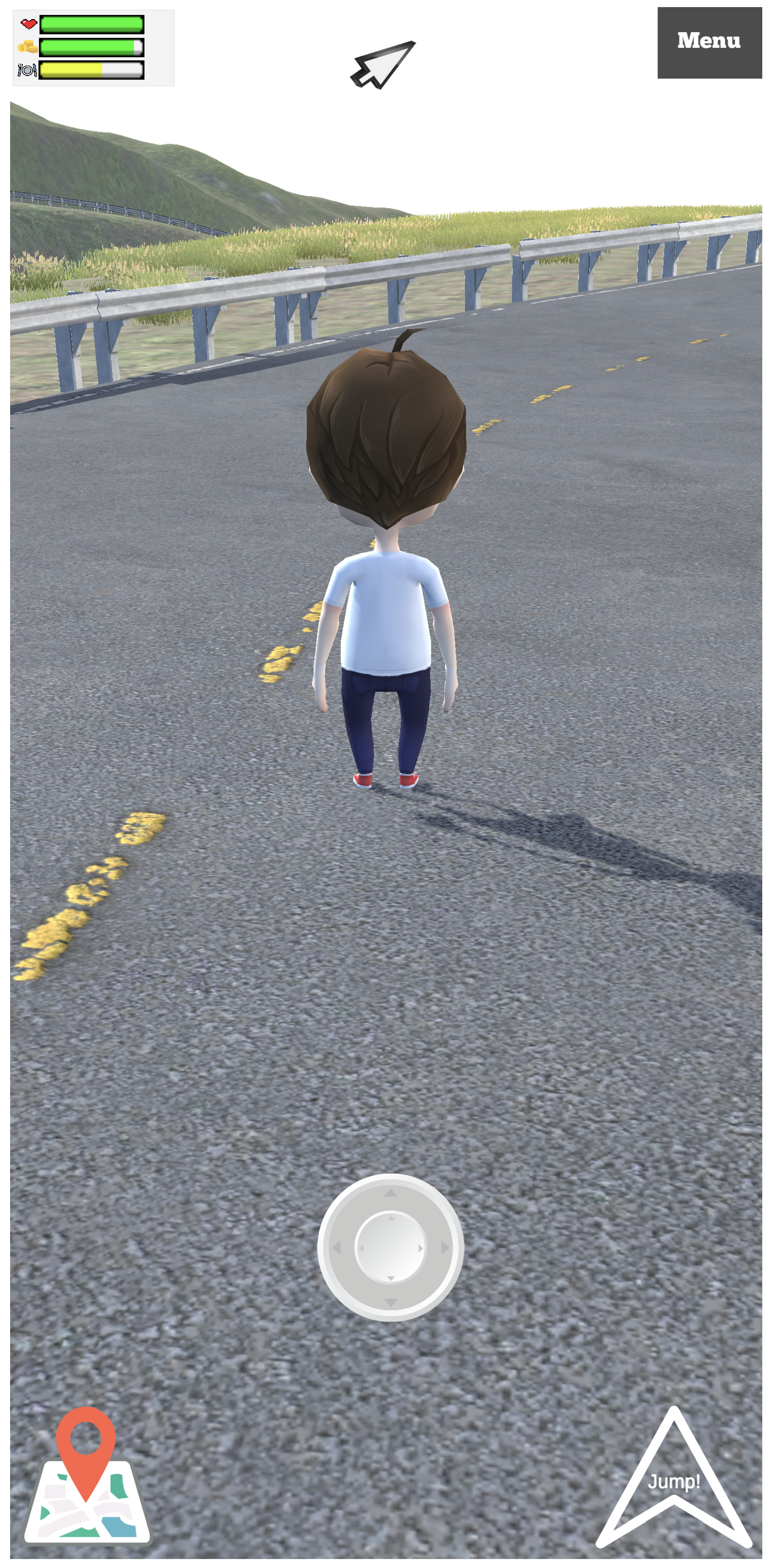
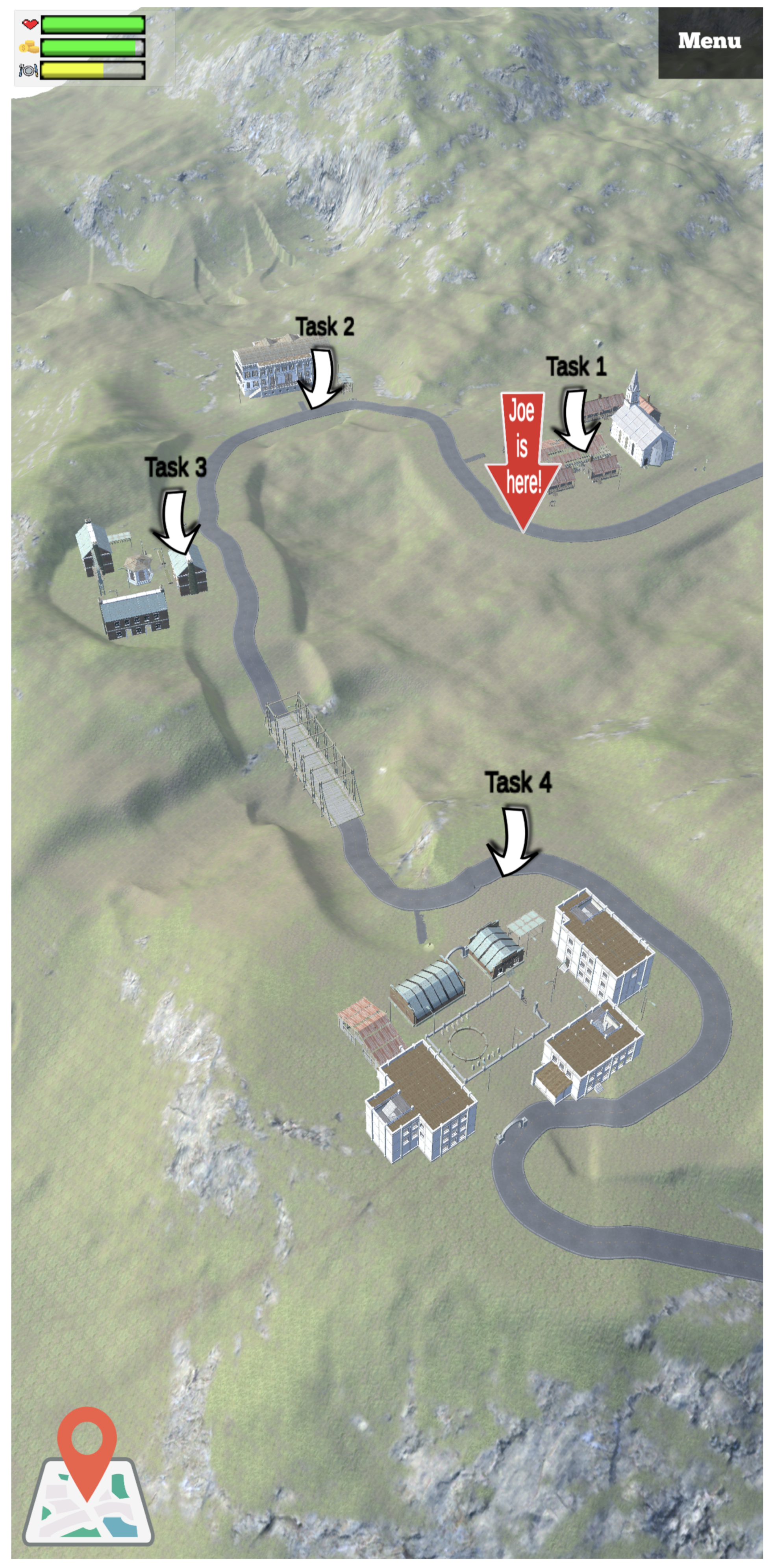


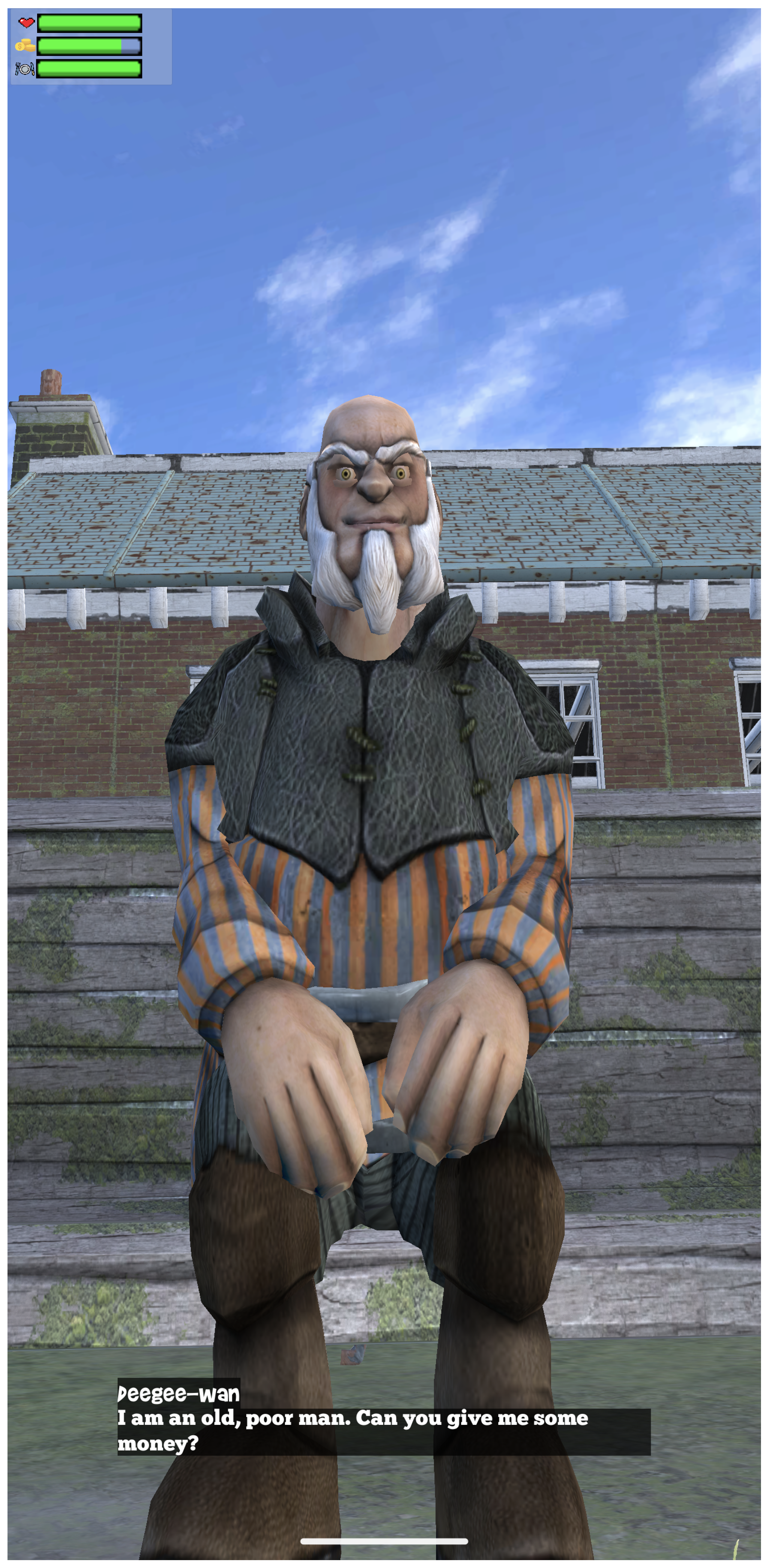
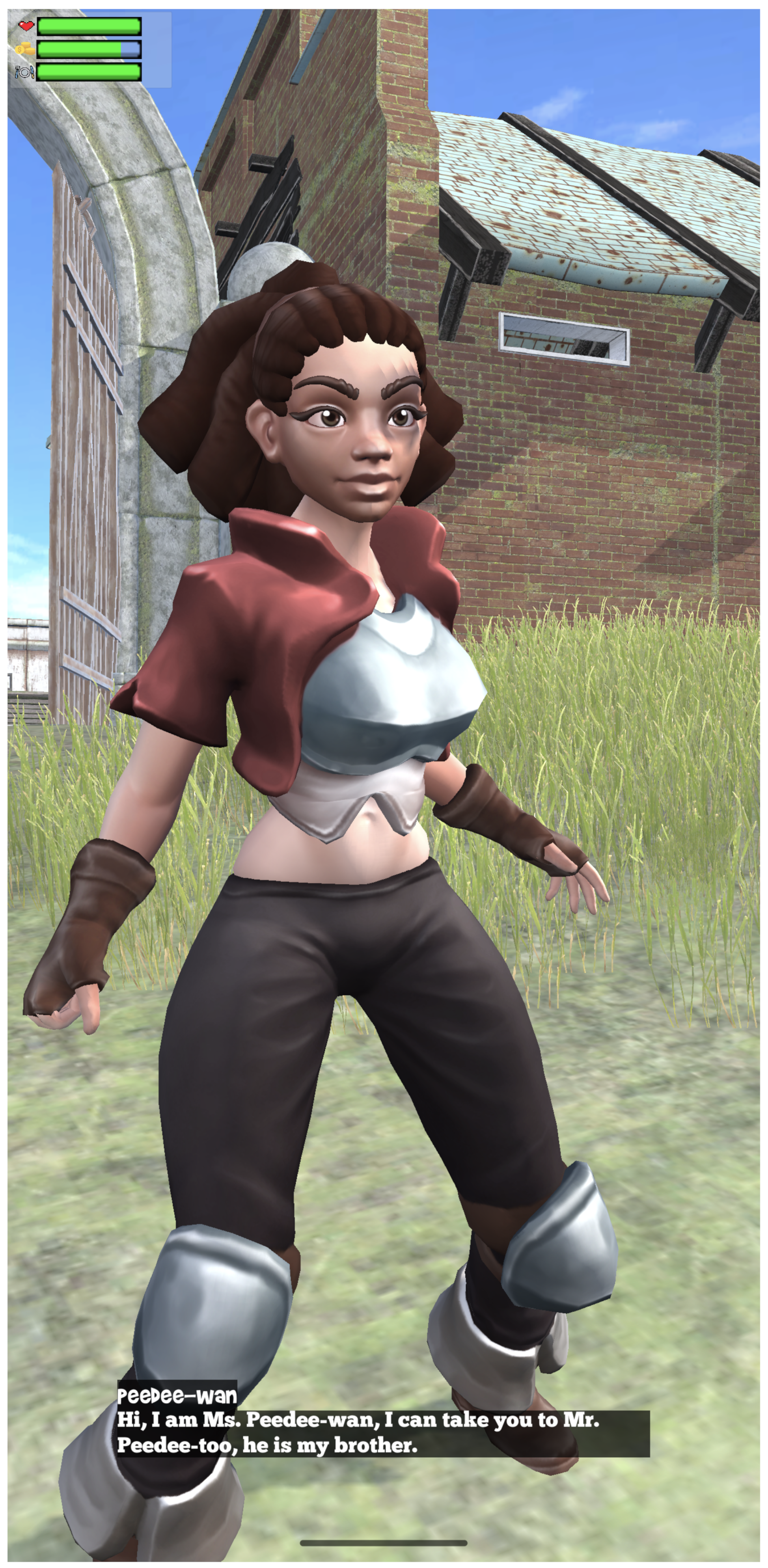
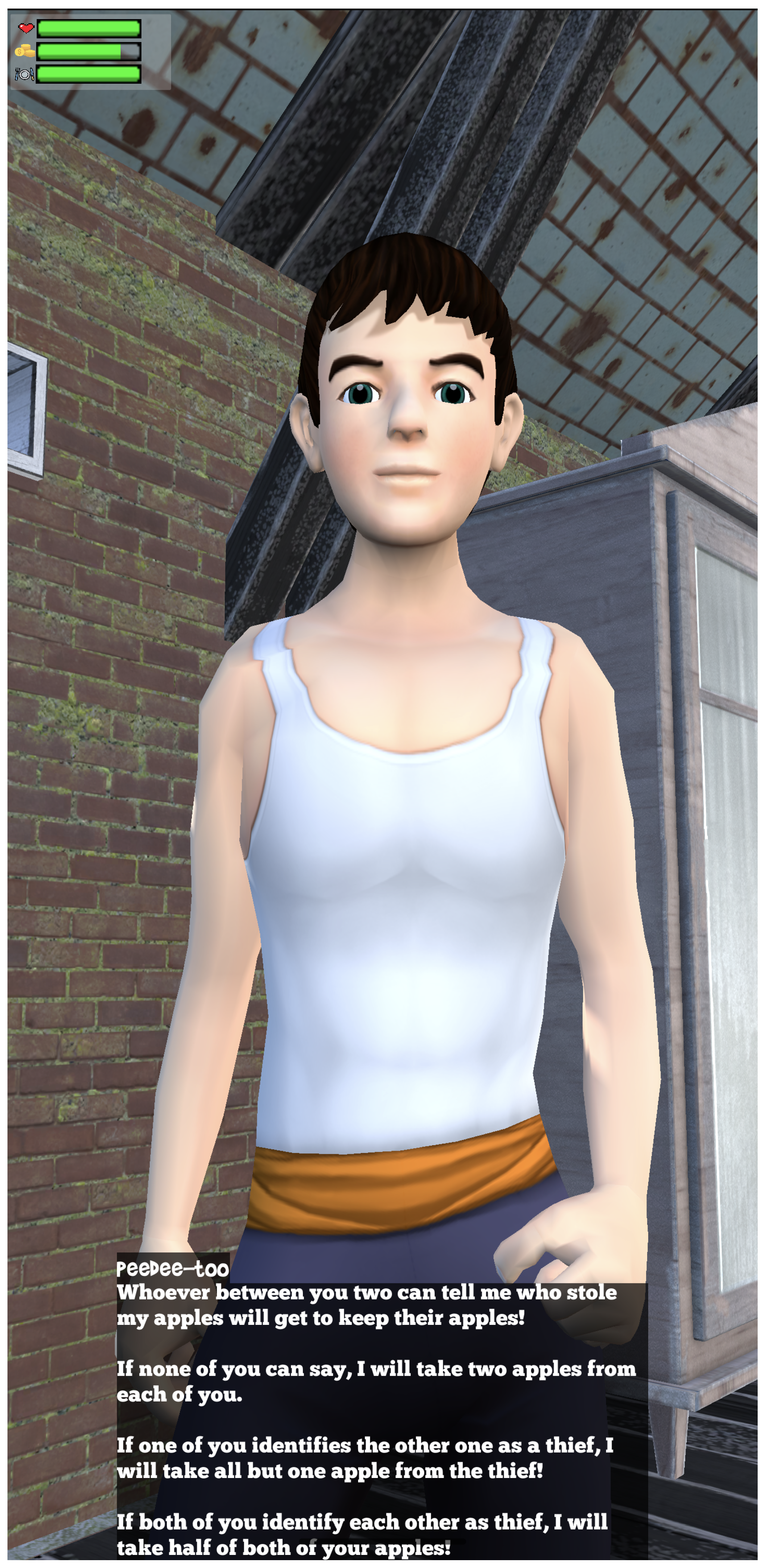
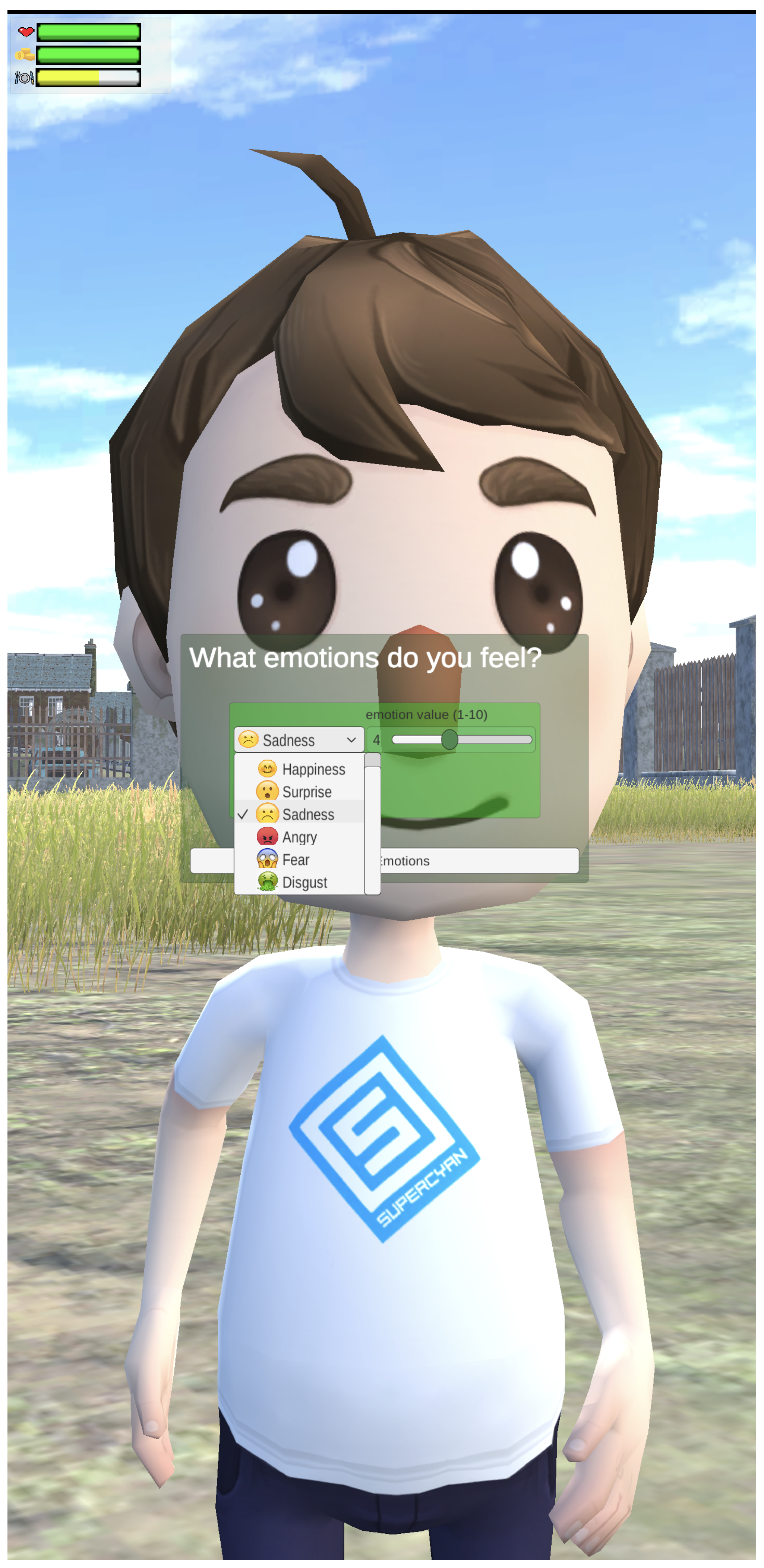
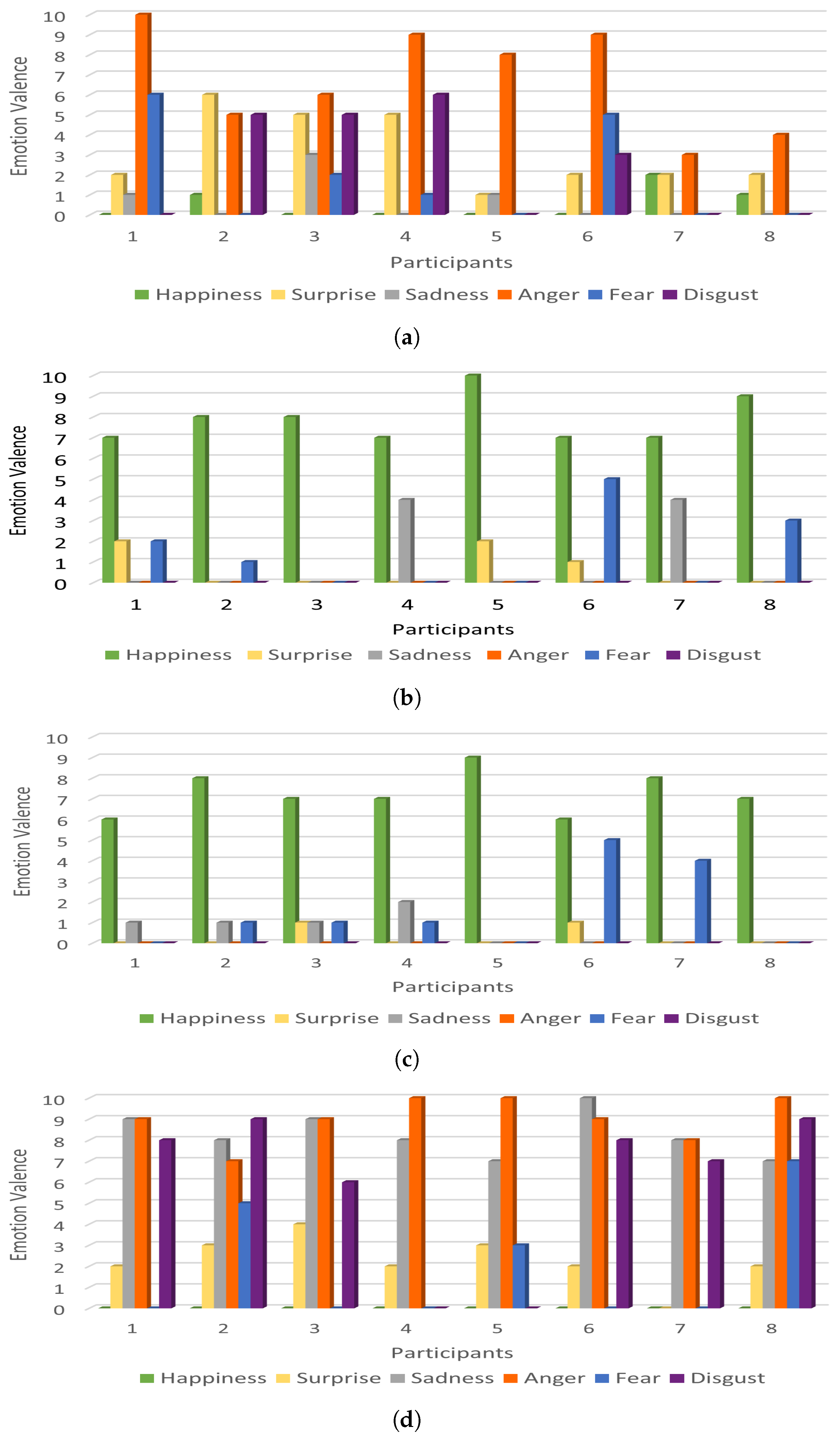


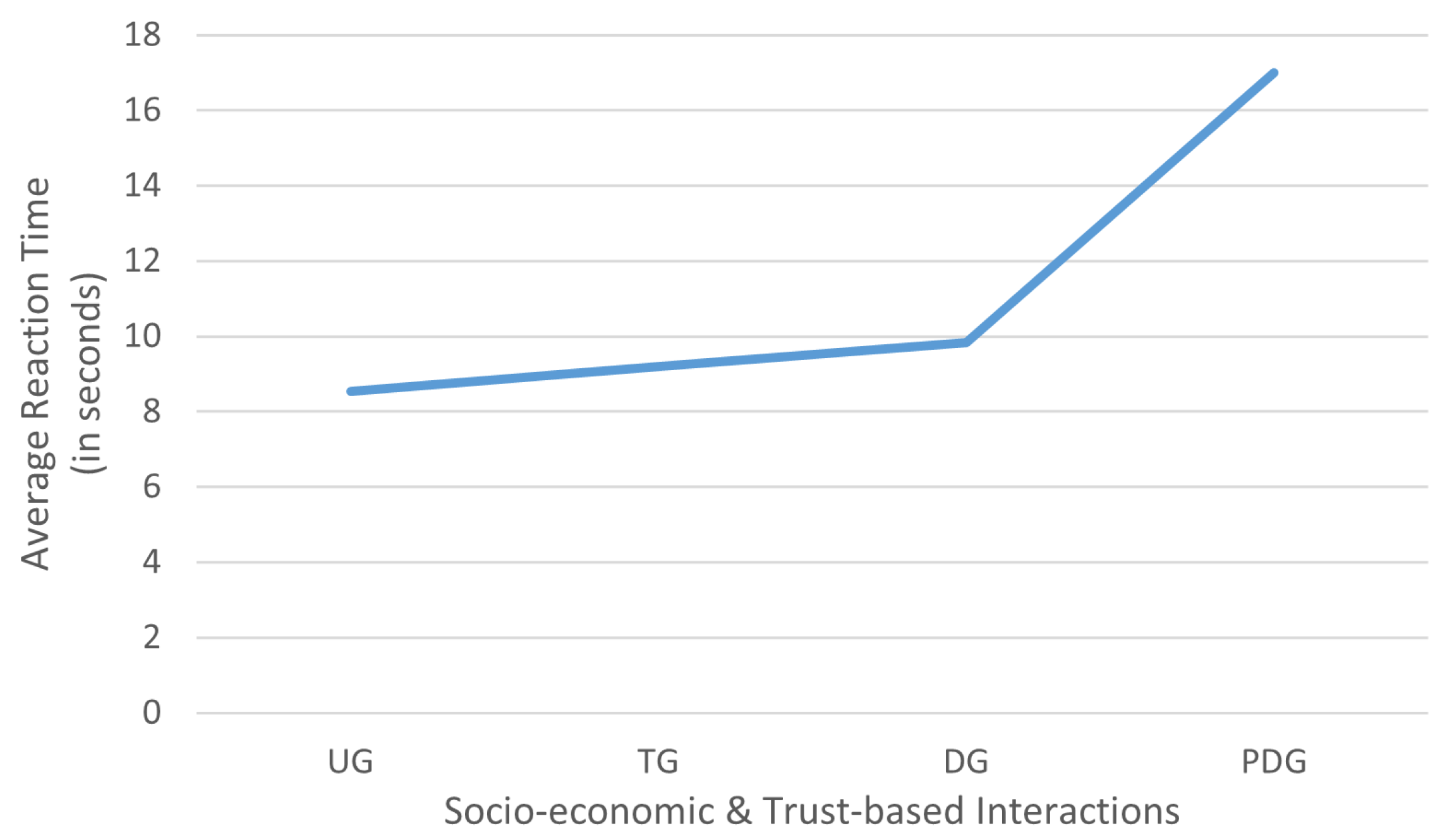
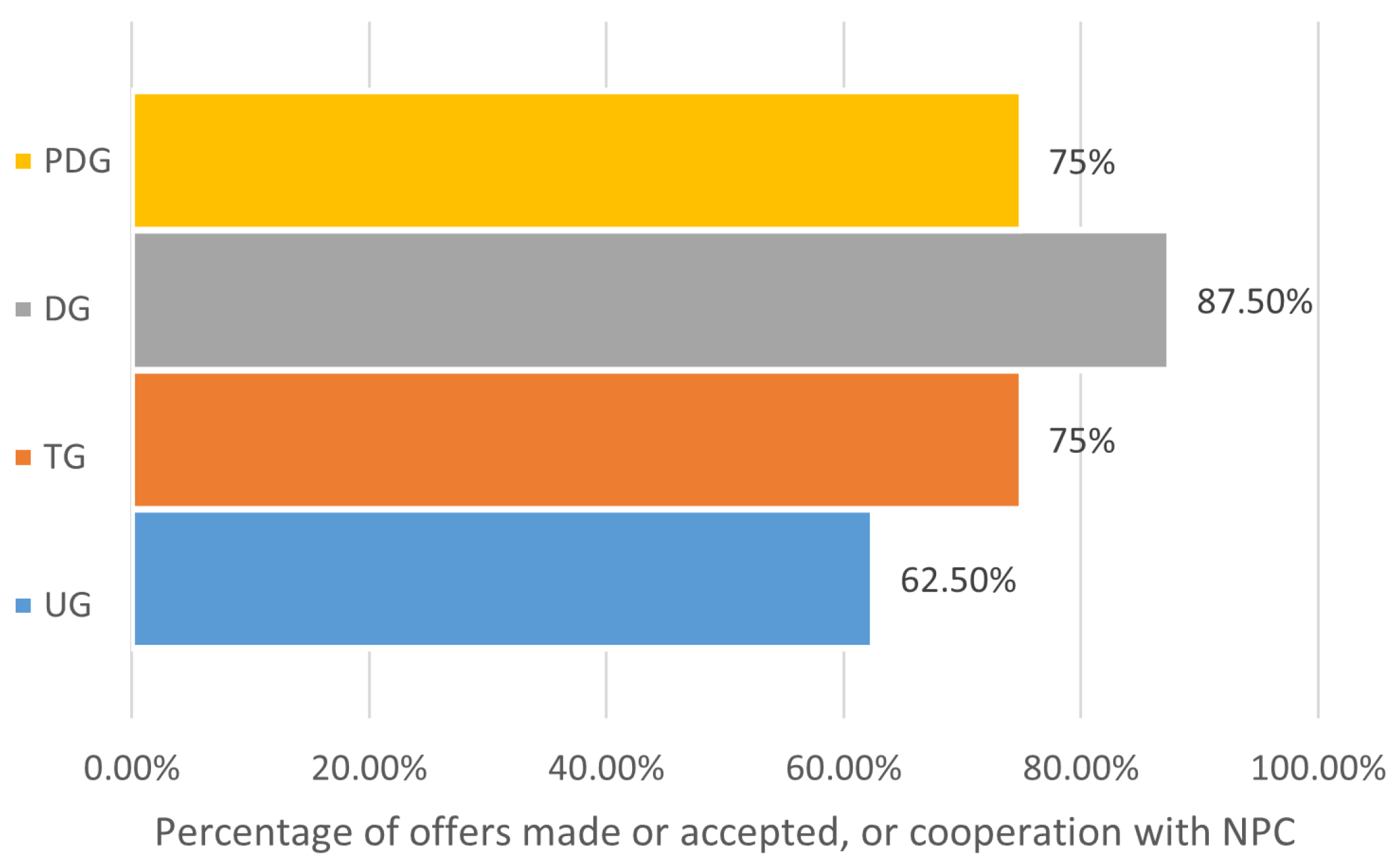

| Socio-Economic Scenario | Type of Pattern | Pattern Observed |
|---|---|---|
| Ultimatum Game * | Decision making | Favours accepting any offer as responder and makes fair but lower offer to maximize profit |
| Emotion Elicitation | Induces sadness when unfair offer is presented and happiness when fair offer is presented | |
| Trust Game * | Decision making | Favours investing smaller amounts in the beginning and defect more often as trustee |
| Emotion Elicitation | Induces sadness and anger when trustee does not return profit shares and happiness for the contrary | |
| Dictator Game * | Decision making | Favours making lower allocations to recipients |
| Emotion Elicitation | Induces happiness in being able to provide any amount of resource to the responder | |
| Prisoner’s Dilemma Game ** | Decision making | Favours cooperative over selfish behaviour |
| Emotion Elicitation | Induces anger, sadness and sometimes disgust when betrayed and happiness for the contrary |
| Feature | Description | Value Type | Value Range |
|---|---|---|---|
| Decision Type | These will be scenarios that will be supplied to our player during the gameplay and will consist of the different games we identified from the literature to be important for depressed individuals | Categorical |
|
| Decision | The decision taken by the player in the game | Categorical | Yes/No/ Made_offer/No_offer |
| Resource | The type of an item of finite quantity that is exchanged during an interaction in the game | Categorical | Food/Money |
| Integral Emotional Response | The emotion valence for the six basic emotions that is self-reported by the player | Continuous | Positive Real Numbers |
| Reaction Time | Amount of time taken by the player to make a decision of interest in the game | Continuous | Positive Real Numbers |
| Interaction Speech Polarity | A measure of how harshly the NPC speaks with the player | Discrete | Integer Numbers (−5 = n = 5) |
| Interaction Expression Polarity | A measure of how negative or positive the NPC shows facial expressions to the player | Discrete | Integer Numbers (−5 = n = 5) |
| Prior Decision | The decision activity the player was involved in prior to the current one, i.e., its value will be NULL for the first Decision-of-Interest (DoI) interaction | Categorical |
|
| Incidental Emotional Response | It is the integral emotional response for the emotional state of the player prior to entering the current DoI interaction | Emotion Vector | Positive Real Numbers |
| Interaction Fairness | A measure of how fair the DoI interaction is | Discrete | Integer Numbers (1 = n = 5) |
| Player Role | Whether the player is the initiator or the recipient of a decision in a DoI interaction | Categorical |
|
Disclaimer/Publisher’s Note: The statements, opinions and data contained in all publications are solely those of the individual author(s) and contributor(s) and not of MDPI and/or the editor(s). MDPI and/or the editor(s) disclaim responsibility for any injury to people or property resulting from any ideas, methods, instructions or products referred to in the content. |
© 2023 by the authors. Licensee MDPI, Basel, Switzerland. This article is an open access article distributed under the terms and conditions of the Creative Commons Attribution (CC BY) license (https://creativecommons.org/licenses/by/4.0/).
Share and Cite
Ahmed, F.; Berta, R.; Bellotti, F.; Lazzaroni, L.; Floris, F.; Barresi, G.; Carrion, J.R. Socio-Economic Decision Making and Emotion Elicitation with a Serious Game in the Wild. Appl. Sci. 2023, 13, 6432. https://doi.org/10.3390/app13116432
Ahmed F, Berta R, Bellotti F, Lazzaroni L, Floris F, Barresi G, Carrion JR. Socio-Economic Decision Making and Emotion Elicitation with a Serious Game in the Wild. Applied Sciences. 2023; 13(11):6432. https://doi.org/10.3390/app13116432
Chicago/Turabian StyleAhmed, Fahad, Riccardo Berta, Francesco Bellotti, Luca Lazzaroni, Federica Floris, Giacinto Barresi, and Jesus Requena Carrion. 2023. "Socio-Economic Decision Making and Emotion Elicitation with a Serious Game in the Wild" Applied Sciences 13, no. 11: 6432. https://doi.org/10.3390/app13116432
APA StyleAhmed, F., Berta, R., Bellotti, F., Lazzaroni, L., Floris, F., Barresi, G., & Carrion, J. R. (2023). Socio-Economic Decision Making and Emotion Elicitation with a Serious Game in the Wild. Applied Sciences, 13(11), 6432. https://doi.org/10.3390/app13116432












